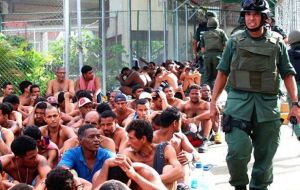MercoPress. South Atlantic News Agency
Crime and violence cost Latin America and the Caribbean 3.55% of GDP
 The region accounts for 9% of the world’s population but contributes nearly one-third of its homicide victims, making it the most violent region outside of war zones.
The region accounts for 9% of the world’s population but contributes nearly one-third of its homicide victims, making it the most violent region outside of war zones.  Six out of ten robberies in the region involve violence and 90% of murders go unresolved. Its prisons are the most overcrowded in the world.
Six out of ten robberies in the region involve violence and 90% of murders go unresolved. Its prisons are the most overcrowded in the world.  ”Crime has reached alarming levels in many countries,” said Ana María Rodríguez, the manager of the IDB’s Institutions for Development Department.
”Crime has reached alarming levels in many countries,” said Ana María Rodríguez, the manager of the IDB’s Institutions for Development Department.  Crime-related costs are on average 3.55% of GDP in Latin America, compared with 2.75% in the US, 2.55% in the UK and 1.34% in Germany.
Crime-related costs are on average 3.55% of GDP in Latin America, compared with 2.75% in the US, 2.55% in the UK and 1.34% in Germany. A study by the Inter-American Development Bank (IDB) estimates the direct annual cost of crime and violence in Latin America and the Caribbean at US$261 billion or 3.55% of GDP, roughly what the region invests on infrastructure and double the average cost for developed countries. It is also the equivalent income for 30% of the poorest population, underscoring the grave development impact violence has on the region.
The Costs of Crime and Violence, New Evidence, New Revelations in Latin America and the Caribbean, is a landmark effort to provide comparable crime costs numbers for 17 countries in the region, benchmarking them against 6 developed countries.
Crime and violence are at near crisis levels in Latin America and the Caribbean. The region accounts for 9% of the world’s population but contributes nearly one-third of its homicide victims, making it the most violent region outside of war zones. Six out of ten robberies in the region involve violence and 90% of murders go unresolved. Its prisons are the most overcrowded in the world.
”Crime has reached alarming levels in many countries,” said Ana María Rodríguez, the manager of the IDB’s Institutions for Development Department. “By providing estimates of the costs of violence at the regional, sub-regional, and national levels, the study will help governments and international cooperation agencies better allocate resources, as well as design better policies to control and prevent crime.”
Crime-related costs are on average 3.55% of GDP in Latin America, compared with 2.75% in the US, 2.55% in the UK and 1.34% in Germany. If the region brings its crime costs down to the level of developed nations, it could increase its infrastructure investment by 50%.
The study breaks down the costs of crime into three parts.
• The social costs include lethal and non-lethal victimization and foregone income of prison populations: 0.64% of GDP
• Private spending on security by business and households: 1.37% of GDP
• Public spending, including the costs to the justice system, spending on police services and spending on prisons: 1.51% of GDP
The estimates are conservative as they include mainly direct costs of crime: public and private spending on security and the social costs. They do not include indirect costs such as changes in behavior due to fear of crime, or the impacts of crime on the health of persons.
As a percentage of GDP, public spending on crime-related areas in Latin America and the Caribbean is similar to the level in developed economies such as the U.S. and the United Kingdom. However, spending is a much bigger portion of public budgets, and private spending on crime prevention is vastly superior to that in more developed nations, the study shows.
The study provides a greater level of detail on how uneven the crime phenomenon is in the region – and within countries. High-crime states in Brazil such as Alagoas y Ceará have costs and rates that mirror more those of Northern Triangle countries (Guatemala, El Salvador and Honduras). Safer areas such as Bello Horizonte and Sao Paolo have numbers closer to Chile and Uruguay.
The study has chapters that analyze crime costs in Brazil, the Northern Triangle and the Caribbean and breaks new ground in calculating the direct costs of homicides as well as the foregone income of the victims of homicides (0.36% of GDP, or an annual average of US$10.5 billion for the 2014-2015 period).
It also points out the steep costs of Latin America’s high incarceration rates. For the 2010-2014 period, the region spent US$6.5 billion per year to maintain and build prisons. On top of this, imprisoned individuals forgo an additional US$7.3 billion annually in income. The two numbers together amount to 0.39% of GDP, more than the conditional cash transfers for the region’s poor.
The study also notes that countries that spend more on prisons do not necessarily reap the benefits of less violence. The Bahamas and El Salvador, for instance, spend large sums (in terms of GDP) on their penitentiary systems but suffer from high crime rates. Argentina and Uruguay, on the other hand, have much lower incarceration costs and lower crime rates.
Costs of violence against women in Latin America and the Caribbean double the world average, and the study points to future avenues for more research on gender violence. The book also includes chapters on cybercrime and organized crime.




Top Comments
Disclaimer & comment rules-

-

-

Read all commentsNo surprises there. An estimated 1000 robberies per 100000 population in Argentina for 2015.
Feb 07th, 2017 - 02:38 am 0'Argentina and Uruguay, on the other hand, have much lower incarceration costs and lower crime rates.'
Feb 07th, 2017 - 06:35 am 0Don't tell me Marti Llazo the racist moron AGAIN caught praising and highlighting the part of the article that trashes Argentina (where in this case?), but ignoring and probably dismissing the part of the article that doesn't?
Who should we trust... a proven Argentine hater (actually a hater of every nationality except his own... .BRITISH, since he has never said a bad thing about them, yet speaks trash about everyone else, surprise he is British! Nope), or this report?
I vote for neither really. Any report that takes a region as Latin America and compares it to the UK or Germany should immediately be dismissed and thrown in the shredder. Latin America is what... 30 times bigger in area than either, and has 4 times the population, with different languages and races and massive geographical distances?
Ridiculous. I should do a report on crime in the UK, and include all of Europe, Magreb, the Caucasus, the Urals, and Israel-Palestine... How much would that data be worth?
Useless report.
@ Pet Troll. Wrong again, pibe. Not British. Not even anglo. Could be ethnic chinese from Singapore but educated in Europe and Canada, for all you know. But keep dreaming and frothing.
Feb 07th, 2017 - 12:43 pm 0The Argentine data on its extraordinary year 2015 rate of about 1000 robberies per 100000 population, the highest in the continent, nay, the hemisphere, is included in that report.
Of course, according to the Pet Troll, we can't compare crime rates because... some countries are bigger than others and speak other languages? Huh? Argie logic.
Commenting for this story is now closed.
If you have a Facebook account, become a fan and comment on our Facebook Page!